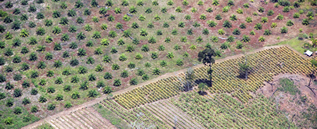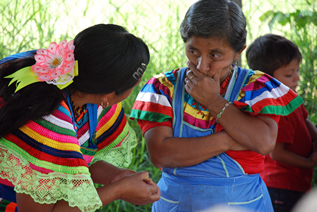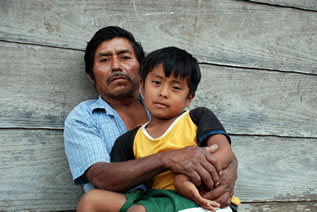Review by Orin Langelle for GJEP
Note: Global Justice Ecology Project’s Anne Petermann and I went to Washington, DC last month to meet with friends and colleagues who were in town for the fall meetings of the infamous World Bank. We arrived in Union Station and hopped on the Metro to Dupont Circle where we met Janet Redman, from the Institute for Policy Studies, at a local restaurant.
We were there to meet Scott Wallace who recently sent me a pre-release copy of THE UNCONQUERED–In Search of the Amazon’s last Uncontacted Tribes. It was the first time I had met Wallace and I had just started reading his book. From the beginning I found the book hard to put down. At the restaurant, I learned a good deal about Scott. Prior to his book, he had written articles for National Geographic. But before that, amongst other assignments, he was a journalist in Central America, who reported on the wars in Nicaragua and El Salvador. One thing that I didn’t find out until later, towards the end of the book, was that, thanks to Wallace, there were now only two degrees of separation between Osama bin-Laden and myself. (More on that later…)
But before the review—below–is a trailer that sets the stage for the book. The grey bearded gentleman in the trailer is Sydney Possuelo and the writer, of course, is Wallace. Possuello is the main character documented by Wallace in The Unconquered. But in all fairness it could be said that the main characters of this book are the ones not seen. The undocumented indigenous tribes of the Amazon jungle.
I’ve worked full-time for social justice for the past four decades, but the last thing I want to do, after my work day is done, is bring home more reality.
For this reason, over the past ten years I’ve read more fiction than non–just because fiction is an escape from dealing with the harsh political and ecological realities of our world today.
So when author Scott Wallace sent me THE UNCONQUERED –In Search of the Amazon’s last Uncontacted Tribes, I said “shit,” more reality to deal with. After reading a few pages, though, I realized that Wallace had set the hook and was reeling me in to a world that most people will never experience or even think about–and that his way of story telling was something special. This is not just a book of nonfiction, nor is it an adventure novel. Wallace has made it both—and fascinating. Hopefully, THE UNCONQUERED will capture the imagination of anyone who reads it, and encourage him or her, while enjoying a lively narrative, to understand the injustices indigenous peoples’ experience, from the past until this day.
THE UNCONQUERED documents Sydney Possuelo’s effort to protect, from his point of view, uncontacted indigenous tribes in the Amazon from the onslaught of civilization. It is also a story of Scott Wallace, who left his family, relationship and everyday life, to set off on a journey into one of the most isolated spots of Brazil’s Amazon rainforest. Through the eyes of Wallace, the book also tells the story of the indigenous people of the region. A people who have chosen to live in their territory, in their ancient culture, and to avoid the death trap of the White Man, that in the Americas can be traced back over 500 years.
Possuelo was the head of Brazil’s FUNAI’s (National Indian Foundation) Department of Isolated Indians. He led thirty-four people in a grueling three month expedition into the depths of Javarí Valley Indigenous Land in a seemingly conflicted effort to consciously not contact or study the isolated inhabitants of The People of the Arrow (flecheiros), but to explore the proximity of their territory—in an effort to document their territory in order to keep intruders out of their territory, to protect their way of life from outside invasion.
The richness of the Amazon brings all types of fortune hunters, from gold diggers to rubber barons to illegal loggers. They set upon the Amazon with a vengeance, pilfering what the Amazon offers. With their invasion come diseases that, along with outright murder, decimate the indigenous populations.
Prior to Possuelo’s involvement in FUNAI, the agency did not have a good reputation when it came to helping indigenous peoples. FUNAI’s idea was to make contact with the natives, pacify and then assimilate them, in order to move them out of the way and open up their lands to development and exploitation.
When Possuelo became the head of the FUNAI’s Department of Isolated Indians, Wallace writes:
“Though not explicitly articulated at the time, Possuelo’s new policy had the immediate effect of sequestering millions of acres of the most species-rich, biodiverse lands on the planet, placing them, at least theoretically, beyond the reach of those looking to exploit their riches. The survival of isolated tribes depended…on intact forests that could provide the Indians with all their necessities: food, water, shelter, security.”
Needless to say all those who sought to make profit from indigenous lands reviled Possuelo—and the missionaries didn’t like him either.
The main purpose of Possuelo’s no contact policy, was to protect the Indians from disease, due to their extreme vulnerability to foreign contagions. One needs only to look at history for proof. Wallace relates that Christopher Columbus’ contact with the Taino people resulted in their extinction within sixty years. Modern demographic studies indicate their population could have been as high as eight million at the time.
More death from disease came to South America with Pizarro (small pox) and subsequent invasions by Europeans. The isolated tribes that still exist are just as vulnerable as ever.
In writing about the details of the expedition, Wallace doesn’t gloss over the tensions between those on the journey and Possuelo—tensions that could have easily led to rebellion–nor does he leave out his own sometimes-painful feelings and actions. It’s quite revealing of who Scott Wallace is.
Wallace’s candid, yet evocative style projects a vivid imagery for the reader and allows a deeper insight into the characters and the situations they encounter. On first view of the expedition participants, Wallace describes them as resembling “a war party returning from a raid: Apocalypse Now meets The Last of the Mohicans.”
On Possuelo:
“He seemed oblivious of the preposterous figure he posed, clad only in his floppy hat and a skimpy Speedo, over which his ample gut spilled.” He then quotes Possuelo arguing that one of the reasons the rainforest was still intact was because, “the Indians formidable reputation had served as a powerful deterrent for decades, perhaps even centuries. ‘Personally I like them like this—violent,’ Posseulo said.”
And on himself, as drops of psychedelic buchité were administered to his eyes:
“I let out a roar. It felt like my eyes were scorched with sulfuric acid. Everyone howled with laughter. It took several minutes for the burning to subside. I opened my eyes and looked around…I beheld a different forest than the one I’ve been marching through for the past four days. It was no longer a two-dimensional, monochromatic screen of dull browns and greens. Everything stood out in sharp, almost psychedelic relief…The colors seemed to vibrate…I wasn’t hallucinating exactly; it was more like looking at the jungle through a 3-D View-Master.”
But Wallace is not merely an adventure junky–far from it. Wallace discusses his fears, his missteps and falls in the jungle, and other personal details that reveal a man who has fortitude but is also frightened in an enormous rainforest, isolated, surrounded by unfriendly creatures from anacondas to jaguars to devouring ants to crocodiles—not to mention the potential contact with The Arrow People and a possible shower of poisonous arrows raining down on the expedition. One small mistake could have been his last.
Critics ask Possuelo if he thought he was depriving indigenous peoples of civilization. Possuelo asserts that if any of them really wanted to make contact, all they had to do was come downriver.
Other critics are sure to say that here is another white man thinking he can save the indigenous peoples because of his feelings of superiority—or guilt. This thought did bother me a bit, but then I recalled a situation where indigenous friends and colleagues asked me to please talk to another white person who said some things they found disrespectful. They impressed upon me that white people should take care of their own when they fuck up. So it could be said that Possuelo was taking care of the whites that were trying to get into the jungle to exploit its riches. But it’s really not my role to judge.
Possuelo had no fondness for the white invaders. Even though law protected the Javarí Valley Indigenous Land he and others fought for, Possuelo knew that laws and land could be over-ruled by a change of government in Brasilia. Maybe he had no right, but he told the contacted indigenous people of the Javarí Valley:
You must say NO to the white man! Tell him: We don’t want loggers, we don’t want fisherman, we don’t want hunters here! The fish are here for us to eat! For us—the Matis, The Marubo, the Kanamari, the Korubu, and yes, the Arrow People, too! The monkeys are for us. The boar, the tapir, the turkeys—they are for us! Tell the white man to stay out! Tell him: We don’t want you here anymore!
In my opinion, if humans are to have a future on this planet and if the Amazon basin is to remain the lungs of the earth and if the indigenous peoples have crucial knowledge most people in the rest of the world don’t, then the capitalist exploiters looking for the last tree to cut down, the last gold to mine to dig, or the last fish to catch, would be well advised to stay out of the Amazon. And just about everywhere else.
So back to the question about Osama bin-Laden’s relation to me. In The Unconquered, Wallace mentions the idea of the six degrees of separation that connect us all in some special way. But what of The Arrow People and other uncontacted—are they somehow connected to the rest of us conquered by civilization? As for the two degrees of separation between bin-Laden and myself, Wallace had a close friend who interviewed bin-Laden in an Afghan cave in 1996, making Wallace one degree separated and now since I’ve met the author only two degrees of separation. Strange things to contemplate in this day and age.
Orin Langelle is the Co-director/Strategist for Global Justice Ecology Project. He is a contributor to many publications, including recent work for Z Magazine, Race, Poverty and the Environment, Earth Island Journal and others. He is currently compiling four decades of his concerned photography for publication and is a member of the National Writers Union and the International Federation of Journalists.









